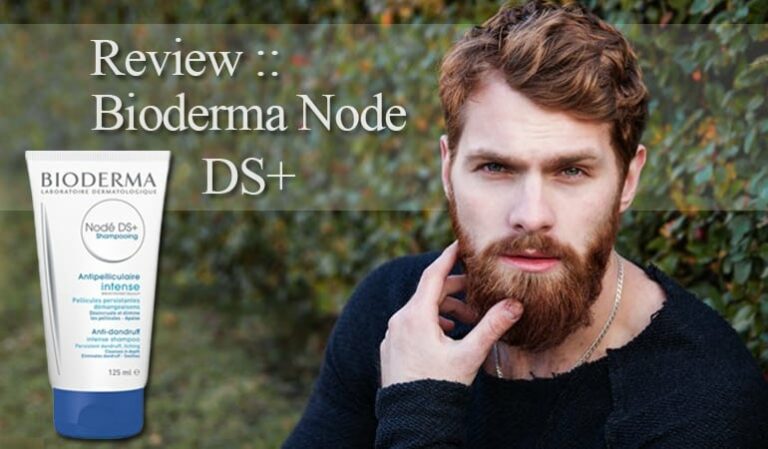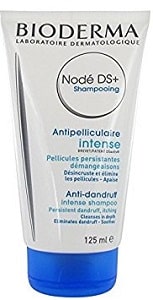Dandruff Deconstructed is reader-supported. All reviews are independent and any products reviewed are purchased by the site owner. To help fund this model, some of the links on the site are affiliate links. If you decide to make a purchase from one of these links, this site will receive some commission. At no cost to you. It helps keeps this place running. Learn more
-
Ingredients
-
Wash
-
Scent
-
Price
Summary
Bioderma Nodé DS+ shampoo certainly packs an anti-dandruff punch. Its combination of anti-dandruff actives (Piroctone Olamine and Zinc Pyrithione), with keratolytic Salicylic Acid and anti-inflammatory Sodium Shale Oil Sulfonate are also complimented by several scalp soothing ingredients. A heck of an ingredients list only let down by the use of SLES and one or two other potential irritants.
This shampoo is definitely worth checking out.
User Review
( votes)
The Bioderma Nodé DS+ shampoo is a 2 pronged anti-dandruff attack also featuring several scalp softening active ingredients. Bioderma themselves claim this shampoo will, ‘limit the proliferation of Malassezia yeasts responsible for dandruff‘ whilst also ‘preventing recurrences by minimizing sebum secretion, which causes Malassezia to spread’. A shampoo that looks set to be a fabulous solution for mild to moderate seb derm and psoriasis.
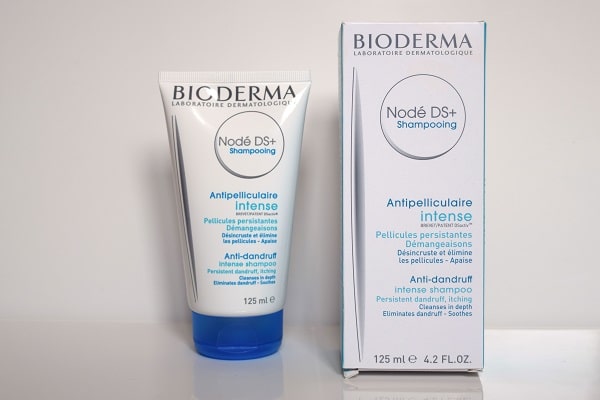
Does its action live up to its lengthy ingredient list? We will soon find out…
Bioderma, the brand and company behind the Nodé DS+ shampoo, is a French-founded company that, to this day, remains privately owned i.e. they’re not a brand (yet!) lying under the large L’Oreal umbrella. The company’s specialty is skin and its dermatological treatment – a value reflected in its numerous skincare brands such as Altoderm, Photoderm, and Secure. As Bioderma themselves put it, ‘Bioderma has acquired unique expertise by placing biology at the service [read forefront] of dermatology’ with their, ‘scientific approach [relying on] first and foremost on knowledge of the skin and its biological mechanisms’. These claims are very much supported by their 8-point charter, with promises dandruff sufferers will swarm to – skin tolerability, dermatological safety, and scientifically recognized active ingredients.
Now, enough about the ‘man behind the curtain’, what about the shampoo itself?
On arrival, the Bioderma Nodé DS+ shampoo is poshly packaged in an outer box and on lifting the lid, a decently sized 125ml face-wash-looking tube is revealed. A little unique for shampoo, the packaging lends itself well to easy in-shower use. A big plus.
As you might expect after reading about Bioderma’s dermatological expertise, the scent of this anti-dandruff shampoo is verging on medical – it’s not yucky, but it’s not indulgently floral either. Nicely sitting on the fence, the scent feels trustworthily medical. Oh, and a nice note here – there are no essential oils and therefore no pesky, irritant-provoking contact allergens.
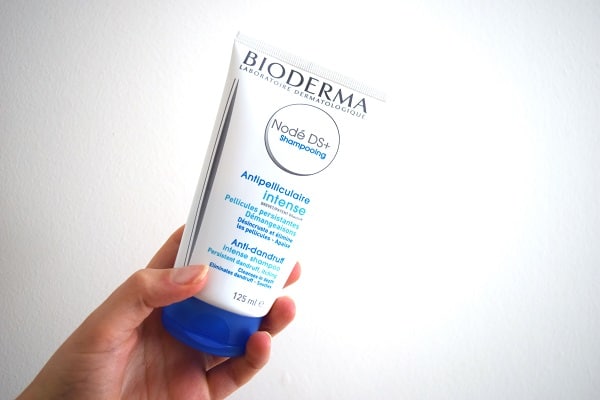
So, just how does it wash?
On application, the Bioderma Nodé DS+ shampoo reveals itself as a slightly thicker than normal shampoo consistency. The formula is off-white and when distributing it between your 2-hands, the consistency is almost gel/jelly-like. A lather is relatively quickly formed and the spreadability is also relatively good. If you’re used to shampoos producing a ‘flash-foam’ you might feel you need to spend a little more time working this product into and around your scalp.
You’ll be happy to hear after use, the formula behaves sensitively, hair and scalp are both left feeling well cared for, and if you have short to medium hair length – a conditioner would be a nice-to-have rather than a must.
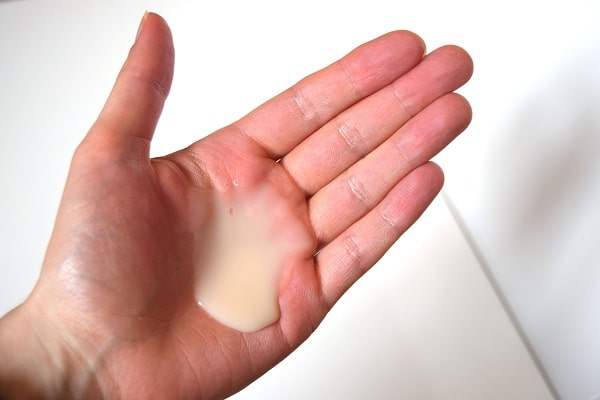
Box 1 is ticked – great wash, what about box 2 – the ingredients?
The Bioderma Nodé DS+ shampoo features 3 well-known anti-dandruff actives and below you’ll find them listed out, in order of quantity;
1. Salicylic Acid
2. Piroctone Olamine
3. Zinc Pyrithione
Our 2-slash-3 pronged dandruff attack begins with salicylic acid, a well-known dry scalp softening agent. Salicylic acid is a keratolytic, meaning it exfoliates away dead skin cell build-up. In Bioderma’s words, ‘Powerful kerato-regulating agents clear severe dandruff and facilitate its elimination.’ This claim is very much thanks to active number 1 – salicylic acid.
In addition to clearing up existing flakes of dandruff, an effective anti-dandruff shampoo will also help to prevent further flakes from being formed. For this, Bioderma has used 2, dandruff treating active, the first – Piroctone Olamine, an effective antifungal used to treat the overgrowth of Malassezia yeasts associated with dandruff attacks. Studies show a combination of 0.75% Piroctone Olamine and 2% salicylic acid is more effective than the more commonly used Zinc Pyrithione in reducing the severity of dandruff scaling. This is great news – the Nodé DS+ shampoo contains Zinc Pyrithione too!
Zinc Pyrithione may be considered the godfather of the anti-dandruff active ingredients family. It’s been used for a long time and its effectiveness was accepted before even scientists knew why it worked. As an antifungal and anti-bacterial Zinc Pyrithione helps to quell populations of the Malassezia yeasts. Dermatological studies show Zinc Pyrithione is able to reverse not just dandruff flaking but also the changes occurring within the skin – whether dandruff is presented or dormant. Factors such as parakeratosis (abnormal maturing of skin cells), disorganization of intercellular lipids, and reduction in desmosomes (adhesion between skin cells).
Overall a combination of active ingredients that should wave a mightily strong goodbye to dandruff, seb derm and psoriasis. Now to the added extras…
The great ones;
• Sodium Shale Oil Sulfonate – anti-inflammatory
• Mannitol, Xylitol, Rhamnose – re-hydration
• Juniperus Oxycedrus Wood Extract – natural anti-microbial
• Zinc Gluconate – involved in skin metabolism
• Laminaria Ochroleuca Extract – boosts skin’s immune system, anti-inflammatory, helping to protect against future irritation and infection
• Zanthoxylum Bungeanum Fruit Extract – potential soothing, anti-itch ingredient
• Pyridoxine HCl (Vitamin B6) – helps to normalize sebaceous gland excretions
• Oleyl and Undecyl Alcohol – two fatty alcohols that will help moisturize your skin and hair
• Caprylic/Capric Triglyceride – a pair of fatty acids I’m seeing more and more of these days. Forms an excellent moisturizer for seb derm sufferers as neither fatty acids feed the yeast that causes seb derm.
…and the not-so-great ones;
• Sodium Laureth Sulfate – strong, often irritating cleansing ingredient known to cause contact dermatitis in some people
• Cocobetaine – The American Contact Dermatitis Society’s, 2014, contact allergen of the Year
• Peg-12 Dimethicone – a silicone-based synthetic texturizer and film former
• Isopropyl Alcohol – a drying ingredient
• Fragrance (Parfum) – often irritating and sensitizing
Wow, just look at those lists, there are a lot of added extras. The total ingredient count comes to 35 and overall many of those ingredients have a lot to add to the efficacy of the Nodé DS+ shampoo.
Sodium Shale Oil Sulfonate, a proprietary ingredient, brings noteworthy anti-inflammatory benefits, with a long history of use for the treatment of a somewhat similar dry-skin condition – eczema.
There’s a second form of Zinc – Zinc Gluconate, an active ingredient noted to regulate sebum, reduce inflammation, and modulate the skins immune system.
We have rehydrating ingredients such as Mannitol, Xylitol, and Rhamnose – complex sugars acting like magnets to water.
The list goes on, but you get the picture – the Bioderma Nodé DS+ shampoo has many, many ingredients that will soothe and recondition your scalp, while also helping to regulate sebum, skin metabolism, and your skin’s immune system.
Now onto list 2, the not-so-great ingredients.
Most of the culprits on this list are low down, meaning they will have less effect than ingredients higher up. At the top of our list, however, we do have the often irritating cleansing ingredient – Sodium Laureth Sulfate. A surfactant is a step better than Sodium Lauryl Sulfate, however still an irritant threat to sensitive scalps.
Lower down the list we have a contact allergen, a synthetic texturizer often thought to ‘cover’ the problem, drying alcohol (although this is far, far down the list), and fragrance. Questionable ingredients, however a balancing low level of them.
So do I recommend it?
Bioderma Nodé DS+ shampoo certainly packs an anti-dandruff punch. Its combination of anti-dandruff actives (Piroctone Olamine and Zinc Pyrithione), with keratolytic Salicylic Acid and anti-inflammatory Sodium Shale Oil Sulfonate are also complimented by several scalp soothing ingredients. A heck of an ingredients list only let down by the use of SLES and one or two other potential irritants.
It’s still one of my personal favorite shampoos and is definitely worth checking out.
